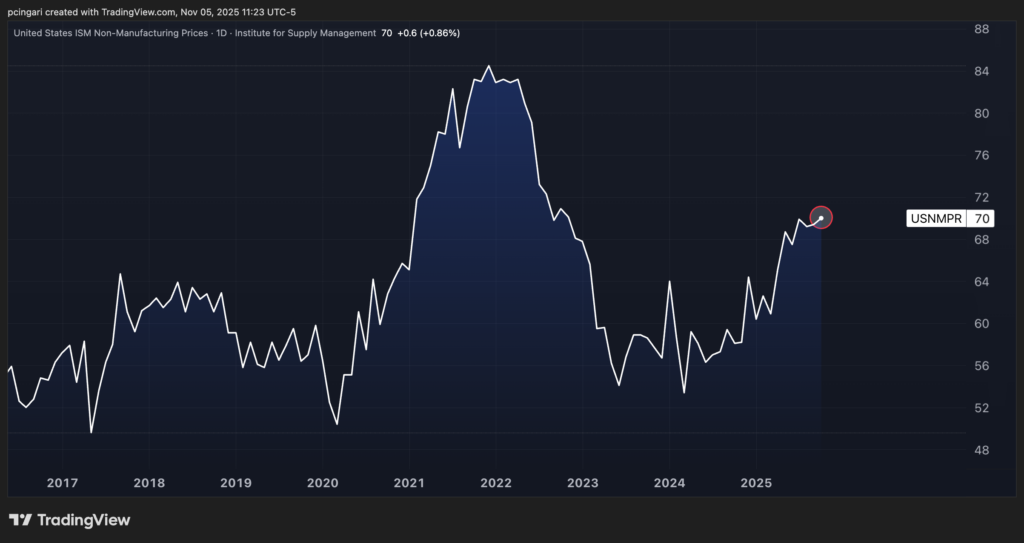
If price pressures have taken a back seat in market conversations lately and much of the tariff anxiety seemed overblown, fresh signs suggest this inflation honeymoon may be ending sooner than expected.
While official inflation data have not shown a dramatic spike—headline inflation still hovers around 3%, stubbornly above the Federal Reserve's 2% goal—there's a growing body of evidence that tariffs are silently doing their part to keep price pressures alive.
With government data sources disrupted by the prolonged Washington shutdown, the private sector has become the market's only compass—and it's pointing to renewed inflation risks.
On Wednesday, a widely watched inflation gauge based on business surveys from the services sector showed cost pressures hitting their highest level in over three years.
While companies have absorbed much of the strain for now, the bigger risk is that the next wave of price hikes gets passed on to consumers.
An Inflation Warning From The Services Sector
The clearest signal of elevated cost pressures from tariffs came from the services sector, which accounts for more than two-thirds of the U.S. economy.
In October, the ISM Services Prices Index jumped to 70%, the highest reading in three years and a level not seen since October 2022. It’s now been above 60% for 11 straight months.

"Respondents continued to mention the impact of tariffs on prices paid," said Steve Miller, chair of the ISM Services Business Survey Committee.
One executive in the Utilities industry noted that tariffs were "causing disruption in contracts" and "driving up pricing on engineered and manufactured equipment," with order delays compounding the strain.
The warning from the services sector adds to similar concerns brewing on the manufacturing side. Earlier this week, the ISM Manufacturing PMI revealed that price pressures remain elevated, with the Prices Index at 58%—marking the 13th straight month of increases.
Respondents from manufacturing-related industries pointed directly to tariffs as a driver of rising input costs.
“Prices on all products have gone up, some significantly. We are trying to keep up with the wild fluctuations and pass along what costs we can to our customers," said an executive from the Machinery industry.
Matthew Martin, senior economist at Oxford Economics, said the recent spike in service prices should serve as a wake-up call.
"The prices index hit a three-year high, with tariffs cited as the largest culprit," he said, warning that while tariff-driven inflation may be peaking, the risks of persistent inflation are rising.
Bill Adams, chief economist for Comerica Bank, commented in an emailed note.
“The Fed will be unhappy to see price pressures intensify in the services PMI but not necessarily surprised,” he said. “Many Fed policymakers have been expecting a delayed pass-through of inflation through the value chain as businesses work through inventories built up ahead of the tariff hikes early this year. That pass-through looks to be continuing in the fourth quarter.”
The Data No One's Watching—But Should Be
In a recent note, Bank of America economists Aditya Bhave and Stephen Juneau estimated that tariffs have already added 30-50 basis points (0.3%-0.5%) to core Personal Consumption Expenditures inflation—one of the Fed's preferred measures.
They indicate consumers are bearing 50-70% of those costs, meaning more inflation could be on the way if businesses start passing along the rest.
According to their analysis, core goods PCE prices—stripping out food and energy—rose 0.2% month-over-month in September, reversing last year's deflationary trend.
Since March, prices have climbed at a 2.2% annualized rate, and current levels sit 1.8% above their 2024 trend.
Their conclusion: "Tariffs have pushed consumer prices higher," and the pass-through isn't over yet.
Alternative Data Echoes The Same Story
Private inflation trackers are picking up similar signals. Harvard's Pricing Lab and Walmart Inc. (NYSE:WMT) price-scraping data from Bank of America show a 3.4% increase in the cost of 101 general merchandise items since mid-April.
Toys—many of which are imported from China and now face the highest effective tariff rate —led the increase.
Another study found that prices for imported goods began rising sharply after October 2024. Compared to domestic goods not affected by tariffs, imported products have seen the fastest and steepest increase.
More Inflation Could Be In The Pipeline
While the current impact of tariffs is significant, the Bank of America team believes further inflation is likely.
They expect more companies to shift rising import costs onto consumers, especially as economic resilience gives businesses room to protect margins. And the rise in tariffs isn't over.
The effective tariff rate on consumer goods has jumped 11 percentage points since January 2025, reaching a level that—if fully passed through—could boost core inflation by 60-70 basis points, according to the bank's rule-of-thumb estimates.
The Supreme Court Wildcard: One major unknown is the Supreme Court's upcoming ruling on tariffs imposed under the International Emergency Economic Powers Act (IEEPA), which account for a significant portion of current duties.
If struck down, the ruling could lower inflation expectations, but analysts expect the administration to pursue alternative legal avenues to keep the tariffs in place.
Either way, the inflation story isn't over.
Read now:
Photo: Shutterstock







